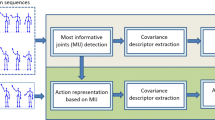Abstract
This paper presents a feature selection comparison oriented to human action recognition only with the kinematic features of skeleton representation. For this purpose, three relevance methods are used to rank the contribution of kinematic features for classifying an action is employed. Particularly, the method with the best results includes the supervised information regarding the action to find out a relevant set of features, encoding the most discriminative information. Experimental results are obtained on a well-known public data (MSR Action3D). Results are encouraging to use kernel theory methods to get better kinematic feature selection for each action with a good generalization indistinct to the subject.
Access this chapter
Tax calculation will be finalised at checkout
Purchases are for personal use only
Similar content being viewed by others
References
Kale, G.V., Patil, V.H.: A study of vision based human motion recognition and analysis. IJACI 7(2), 75–92 (2016)
Mandery, C., Plappert, M., Sol, J.B., Asfour, T.: Dimensionality reduction for whole-body human motion recognition. In: 19th International Conference on Information Fusion, FUSION, Heidelberg, Germany, 5–8 July 2016, pp. 355–362 (2016)
Althloothi, S., Mahoor, M.H., Zhang, X., Voyles, R.M.: Human activity recognition using multi-features and multiple kernel learning. Pattern Recogn. 47(5), 1800–1812 (2014)
Li, M., Leung, H., Liu, Z., Zhou, L.: 3D human motion retrieval using graph kernels based on adaptive graph construction. Comput. Graph. Pergamon 54, 104–112 (2016)
Wang, L., Zhao, G., Cheng, L., Pietikainen, M.: Machine Learning for Vision-Based Motion Analysis, 1st edn. Springer, Heidelberg (2011)
Wei, X.K., Chai, J.: Modeling 3D human poses from uncalibrated monocular images. In: IEEE 12th International Conference on Computer Vision, ICCV, Kyoto, Japan, 27 September–4 October 2009, pp. 1873–1880 (2009)
Li, W., Zhang, Z., Liu, Z.: Action recognition based on a bag of 3D points. In: IEEE Conference on Computer Vision and Pattern Recognition, CVPR Workshopps 2010, San Francisco, CA, USA, 13–18 June 2010, pp. 9–14 (2010)
Ravet, T., Tilmanne, J., d’Alessandro, N.: Hidden Markov model based real-time motion recognition and following. In: Proceedings of the 2014 International Workshop on Movement, Computing, MOCO 2014, pp. 82–87. ACM, New York (2014)
Jiang, Y., Saxena, A.: Modeling high-dimensional humans for activity anticipation using Gaussian process latent CRFs. In: Robotics: Science and Systems X, University of California, Berkeley, USA, 12–16 July 2014 (2014)
García-Vega, S., Álvarez-Meza, A.M., Castellanos-Domínguez, C.G.: MoCap data segmentation and classification using kernel based multi-channel analysis. In: Ruiz-Shulcloper, J., Sanniti di Baja, G. (eds.) CIARP 2013. LNCS, vol. 8259, pp. 495–502. Springer, Heidelberg (2013). doi:10.1007/978-3-642-41827-3_62
Pulgarin-Giraldo, J.D., Alvarez-Meza, A.M., Melo-Betancourt, L.G., Ramos-Bermudez, S., Castellanos-Dominguez, G.: A similarity indicator for differentiating kinematic performance between qualified tennis players. In: Beltrán-Castañón, C., Nyström, I., Famili, F. (eds.) CIARP 2016. LNCS, vol. 10125, pp. 309–317. Springer, Cham (2017). doi:10.1007/978-3-319-52277-7_38
Diaz-Martinez, N.F., Pulgarin-Giraldo, J.D., Vinasco-Isaza, L.E., Agredo, W.: Analysis of the alignment angles and flexion angle in women with patellofemoral pain syndrome. In: Torres, I., Bustamante, J., Sierra, D. (eds.) CLAIB 2016. IFMBE Proceedings. Springer, Singapore (2016)
Yang, X., Tian, Y.: Effective 3D action recognition using eigenjoints. J. Vis. Commun. Image Represent. 25(1), 2–11 (2014)
Yang, X., Tian, Y.: Eigenjoints-based action recognition using Naïve-Bayes-Nearest-Neighbor. In: CVPR Workshops, pp. 14–19. IEEE Computer Society (2012)
Ofli, F., Chaudhry, R., Kurillo, G., Vidal, R., Bajcsy, R.: Sequence of the most informative joints (SMIJ): a new representation for human skeletal action recognition. J. Vis. Commun. Image Represent. 25(1), 24–38 (2014)
Alvarez-Meza, A.M., Velasquez-Martinez, L.F., Castellanos-Dominguez, G.: Time-series discrimination using feature relevance analysis in motor imagery classification. Neurocomputing 151(Part 1), 122–129 (2015)
Brockmeier, A.J., Choi, J.S., Kriminger, E.G., Francis, J.T., Principe, J.C.: Neural decoding with kernel-based metric learning. Neural Comput. 26(6), 1080–1107 (2014)
Zeng, X., Wang, Q., Zhang, C., Cai, H.: Feature selection based on reliefF and PCA for underwater sound classification. In: Proceedings of 3rd International Conference on Computer Science and Network Technology, pp. 442–445 (2013)
Acknowledgments
This work is supported by the project number 36075 funded by Universidad Nacional de Colombia sede Manizales, by program “Doctorados Nacionales 2014” number 647 funded by COLCIENCIAS, as well as partial Ph.D. financial support from Universidad Autonoma de Occidente.
Author information
Authors and Affiliations
Corresponding author
Editor information
Editors and Affiliations
Rights and permissions
Copyright information
© 2017 Springer International Publishing AG
About this paper
Cite this paper
Pulgarin-Giraldo, J.D., Ruales-Torres, A.A., Alvarez-Meza, A.M., Castellanos-Dominguez, G. (2017). Relevant Kinematic Feature Selection to Support Human Action Recognition in MoCap Data. In: Ferrández Vicente, J., Álvarez-Sánchez, J., de la Paz López, F., Toledo Moreo, J., Adeli, H. (eds) Biomedical Applications Based on Natural and Artificial Computing. IWINAC 2017. Lecture Notes in Computer Science(), vol 10338. Springer, Cham. https://doi.org/10.1007/978-3-319-59773-7_51
Download citation
DOI: https://doi.org/10.1007/978-3-319-59773-7_51
Published:
Publisher Name: Springer, Cham
Print ISBN: 978-3-319-59772-0
Online ISBN: 978-3-319-59773-7
eBook Packages: Computer ScienceComputer Science (R0)




